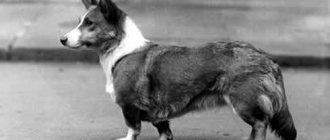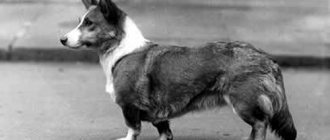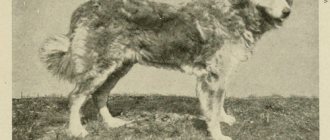There are two varieties of corgis, the Pembroke and the Cardigan, which get their names from the counties where they were bred.
There, both species established themselves as herding dogs and for a long time they dutifully performed their duty.
Therefore, the Corgi’s abilities are appropriate.
The dog has good inclinations, most of which boil down to charisma, and in terms of mental abilities it is a worthy competitor to its fellow colleagues.
Therefore, proper training is an integral part of keeping these dogs.
Welsh Corgi breeds
The dogs were bred in Wales and are divided into two breeds. They're called:
- Welsh Corgi Cardigan;
- Pembroke Welsh Corgi.
Dogs of different breeds lived in neighboring counties, but did not intersect, so there were many differences between them.
Their similarities are only in their small stature, unusual short legs and peculiar ears, as well as in their wonderfully loyal character.
Cardigan is larger, stockier and his face, even in the photo, will remind you of a miniature shepherd dog. The Pembroke is not such an ancient breed as the Cardigan, it looks more aristocratic and sophisticated, a bit like a Spitz.
Photo of Welsh Corgi Cardigan
Their main difference is the tail. Cardigans have a long and wide tail, while Pembrokes have no tail or have one docked at birth.
Cardigan Welsh Corgi puppies behave more respectably and reservedly, they are very loyal. Pembroke puppies are very playful and friendly, more active.
It’s up to you to decide which breed you choose, but in any case, such a dog will become your reliable friend.
At what age do you start training?
Puppy training must begin from the very first days
the presence of a dog in your home. Because already from infancy, the puppy must learn the rules of behavior in your house, what is allowed and what is forbidden, how to behave with all family members, even the smallest and oldest, what he can play with and what he can’t, where to go. toilet and much more.
And we are talking, first of all, about the proper upbringing of a Pembroke Welsh Corgi puppy, and you can start training and learning commands when the puppy is completely comfortable in your home. As a rule, one week is enough. By this time, the puppy is already filled with curiosity and is diligently exploring the world around him. If, after this time, the puppy remains fearful and does not make contact well, then it is better to seek help from a dog handler-animal psychologist, because This behavior is not typical for puppies of this breed.
When can you start training with a dog handler?
The beginning of the puppy's training coincides with the time of the first exit to the street. When the first two vaccinations have already been done, the quarantine (lasts 7-14 days, depending on the vaccination) after them is over. It is not at all necessary to train your puppy only outside; the first sessions are best done at home, where there are fewer distractions.
Often new puppy owners worry that training from the first days will be excessively stressful for the dog. This is only possible if outdated, rigid methods are used, and with the right approach, training from the first days will, on the contrary, be very useful, since it allows you to immediately establish contact
with the puppy and build a trusting relationship.
You can start raising a puppy from the first days of its appearance in your home, and training and classes with a dog handler can begin simultaneously with the start of walks, when quarantine ends after the second vaccination.
Why you don't need to wait up to 6 months
You often hear that the Pembroke Welsh Corgi, like other dogs, cannot be trained before 6 months, because training is stressful. This opinion remains from the times of outdated methods based on cruel coercion and intimidation of the dog. Unfortunately, there are still plenty of dog handlers using similar techniques today. But fortunately, science does not stand still and modern techniques make it possible to train a puppy from the first days in a new home. Therefore, you should not wait until your Pembroke Welsh Corgi puppy develops unwanted behavior; you can start training much earlier.
Command training
Trained corgis must unquestioningly follow the orders of their owner. To achieve perfect obedience from a mini-shepherd, it must be taught basic commands.
To me
This is one of the most important commands, so special attention is paid to its development in the process of raising and training corgis. The puppy is shown a treat by saying the command “Come to me.” As soon as he approaches, he is sure to be encouraged.
Near
The corgi is taken on a leash, placed to the left of itself and, pronouncing a command, is encouraged to follow itself. For correct execution of the order, the corgi is treated to a treat.
Voice
The puppy is seated in front of you, and a hand with a treat is raised above its muzzle, pronouncing the appropriate command. As soon as the corgi barks, he is praised and treated with a treat.
Sit
Hold a treat in one hand and raise it above the puppy. With the second palm, lightly press the Welsh Corgi’s croup, while simultaneously pronouncing the command “Sit!”
Place
The puppy is placed on its bed and held there, repeating the appropriate command. After a couple of minutes, he is rewarded with a treat and released. Gradually, the time the Welsh Corgi spends on the bedding is increased, and so that he does not have the desire to leave his place, toys are left for him.
Lie
A sitting puppy is ordered to “Lie down!” and lower a hand with a treat in front of his nose, at the same time lightly pressing on the withers. As soon as the Welsh Corgi follows the command, he is praised.
It is forbidden
This is an important prohibiting command, the execution of which must be brought to perfection. When a puppy wants to grab something from the ground, he is pulled back with a leash and commanded “No!”
Ugh!
This command has the same meaning as the previous one. Therefore, in the process of raising and training a puppy, it is enough to practice one of them.
Training scheme by month
To avoid overtiring the corgi, training is carried out in stages. Classes are strictly limited in time, and tasks for the puppy are gradually made more difficult.
At 2 months
This period coincides with the puppy moving to a new home and with post-vaccination quarantine, so the little corgi is given some time to adapt and get used to the owners. At the same time, the puppy is taught:
- respond to nickname;
- going to the toilet while wearing a diaper;
- play only with your own toys;
- behave quietly when alone;
- Treat the collar and leash calmly.
Also during this period, the puppy is weaned from biting and damaging the owner’s property.
At 3 months
At this age, quarantine ends and the puppy goes outside for the first time. Now he is taught to go to the toilet outside the house and shown that he should not take treats from the hands of strangers.
Also, from 3 months, an important stage of education begins, which is called socialization. At this age, the Corgi puppy’s nervous system is developing, so as soon as he gets used to walks and is no longer afraid of the street, he is introduced to different stimuli.
This is done very carefully so as not to scare the baby. The puppy is taught to be calm towards strangers, strange animals, transport and loud noises.
At 4-5 months
A puppy of this age already has time to get comfortable both at home and on the street, so at 4-5 months the corgi often begins a period of disobedience. The puppy, having played with its relatives, pretends that it does not hear its owner and is in no hurry to run to his call. During this period, you can begin full training. At 4-5 months, a corgi puppy is taught:
- return to the owner on the first command;
- move around calmly on a leash and without a leash;
- be indifferent to treats scattered on the ground;
- follow the commands “Stand!”, “Sit!”, “Lie down!” and “Place!”;
- patiently wait for the owner at the shutter speed.
On a note. First, one command is practiced until it becomes automatic, and only then the development of the next skill begins.
From 6 months
At six months, the corgi begins puberty and the dog can re-test the boundaries of what is permitted, deliberately not following commands. Therefore, from 6 months, corgi training comes down to filling gaps in education and correcting unwanted behavior.
Where to buy a Welsh Corgi dog?
Welsh Corgi puppies should be purchased from professional breeders or from a kennel with an impeccable reputation. You may want to save money and buy a pet from a regular ad on the Internet, but be prepared for the fact that the puppy will not be a real corgi.
Photos of red Welsh Corgi puppies
A purebred dog with a good pedigree cannot be cheap. The price varies from 20,000 to 50,000 rubles.
In the corgi nursery, the puppies will be absolutely healthy and will receive the necessary vaccinations. You will be able to take your new four-legged friend home no earlier than he is three months old.
Training at 3 months. Socialization
Three months is an important stage in a Pembroke Welsh Corgi puppy’s introduction to the outside world. Your first walks should be short and not too tiring for the puppy. You should start with 15 minutes, gradually increasing the walking time to 1 hour.
Correct formation of the nervous system
At this age, the puppy’s nervous system is forming.
. It has been proven that raising puppies in isolation during this important period contributed to the development of pronounced cowardice in them later. It is necessary to show the puppy as much as possible: noisy streets, large crowds of people, etc. Everything that he will have to face in later life.
This must be done very carefully, gradually, over and over again increasing the time spent in noisy places, so as not to overload the puppy or frighten him.
The territory of a country house, cottage or village are places with a minimum amount of external stimuli for a city dog. Therefore, if you plan to keep a dog in an urban environment, “growing up” a Pembroke Welsh Corgi puppy in such conditions depleted of irritants is unacceptable.
A city puppy must grow up in the city, in conditions that are saturated with external stimuli, such as: noisy streets, large crowds of people, other animals, birds, cyclists, cars, etc.
Meeting people and dogs
It is necessary to introduce the puppy to friendly dogs and people
so that later the puppy does not develop aggression or cowardice caused by the fear of new things and the inability to communicate and make new acquaintances. Currently, unfortunately, this is not uncommon in the behavior of adult dogs, but a fairly common problem with which people turn to our specialists for help.
Puppy behavior on the street
The emergence of new places leads to new rules that need to be consolidated:
- Now you can and should go to the toilet on the street, and not stoically endure it, carrying everything home;
- Not every new person or dog wants to communicate, so you don’t need to run headlong to meet everyone;
- Not all food is healthy, so it should only be taken from the owner’s hands.
Training and practicing commands
Training a puppy follows the same principles as at 2 months. It should be remembered that at this age puppies develop conditioned reflexes quite easily, but they are forgotten just as quickly, so you should not scold the puppy for not following commands, especially if they have not been repeated for a long time, but you should pay more attention to learning new things and repeating already covered material .
Features of early sowing
It is worth remembering that the February sowing season has its own subtleties, so thoughtlessly filling window sills with seedling boxes and cups is unlikely to pay off in the future with a generous harvest of vegetables or lush flowering of ornamental plants.
This month allows seedlings to be sown only with late-ripening and slow-growing crops that have a long growing season. Therefore, before “gutting” the stocks of stored seeds, turn the packages over and carefully read the characteristics of each crop.
In February, crops with a long growing season are sown for seedlings.
The region where you live is also important. In February, residents of the southern regions can afford to sow seeds for seedlings, who will, without fear, plant the strong seedlings in open ground at the end of April or beginning of May.
The weather conditions of the Moscow region and other central cities are unlikely to allow seedlings to be transplanted into unprotected soil within this time frame. Therefore, at the end of winter, only those who have a greenhouse or greenhouse on their site will be able to enjoy the troubles of seedlings. But for residents of the northern regions, it’s probably too early to worry - February sowing in your case is justified only for owners of good-quality heated greenhouses.
The timing of sowing seedlings varies in different regions
Also, do not lose sight of one more point - the time of seed germination. When calculating the time for sowing seedlings, you must first decide on the moment of planting them in the ground or greenhouse in your region and count back the number of days required to grow seedlings at home. Then, from the received date, you need to subtract a few more days (or weeks), during which the seeds of the “calculated” crop will sprout and produce full shoots above the soil surface (that is, straightened sprouts with open cotyledon leaves).
Full seedlings are seedlings with open cotyledons
As a result, you can easily determine when exactly you can start planting and fill the window sills with the long-awaited green colors.
What do you need to have at home when purchasing a Welsh Corgi?
You need to prepare for the arrival of a Welsh Corgi puppy and purchase several things:
- a bowl for food and water;
- collar and leash for walking;
- several different toys;
- food recommended by the breeder;
Collar and leash for walking
- a house where the dog will sleep, or a sun lounger;
- brush or comb;
- flea remedy (if the dog was not treated for fleas at the kennel).
Pepper
At the same time, bell pepper seedlings are sown, which can be transplanted to a permanent place 50-65 days after germination. If you sow dry pepper seeds, it takes 10-12 days to germinate. Therefore, it makes sense to pre-wet the seed before swelling in a solution of some stimulant (for example, take Epin). Then the seeds need to be slightly dried to a free-flowing state and sown in the prepared container.
How to care for the Welsh Corgi breed?
Both Cardigan and Pembroke puppies do not require special care. The only problem you will encounter is the wool. Unfortunately, these dogs shed a lot and you will need to brush them frequently.
They should be bathed only when they get dirty, and after walking through the mud, you can simply wipe their paws with a damp cloth.
Inspect your pet's claws weekly and, if necessary, trim them with a special device - a nail clipper.
Nail clipper for dogs Pay attention to the dog's eyes, they should be clean, without purulent discharge.
You will also need to clean your pet's ears and teeth. Under no circumstances should you trim your Welsh Corgi's coat. If you participate in exhibitions, you should know that the standard is the unaltered appearance of the wool.
Training and physical activity
Cardigan Corgis are easy to train and easy to train. Without proper demands, confidence, and consistency, coaches may resist a little. It is advisable not to use treats during the training process, but to use verbal praise or stroking. The dog is inquisitive, therefore it requires setting a variety of tasks and constant mental stress.
When walking with your Welshie every day, try to use active games so that your dog can throw out the energy that has accumulated while he was sitting at home. Regular exercise will help stabilize weight and improve your pet’s health and mood. When walking, use a harness rather than a leash. It is undesirable for this type of animal to run down stairs, overcome high barriers and jump from heights. Heavy stress on the back is not recommended.
A naturally wary, suspicious dog requires early socialization; prevent unnecessary aggressiveness. Under no circumstances use force, rudeness, or aggression when raising a child.
As with most pets, early training, care, and education will help to avoid stubbornness, anger, and uncontrolled behavior of the animal. Give commands clearly, firmly, consistently, even if you are using a game to learn. Your efforts will be rewarded with an intelligent, well-mannered, obedient dog.
Health
Welsh Corgis, like all herding dogs, are naturally endowed with good health and strong immunity. But there is still a predisposition to certain diseases:
- Spinal diseases - sometimes occur due to an elongated torso.
- Von Willebrand disease is a hereditary disease characterized by blood clotting disorders and spontaneous bleeding. Often leads to death.
- Epilepsy – accompanied by seizures.
- Hip dysplasia is a deformation of the joints, accompanied by severe pain and lameness.
- Raw eczema – skin lesions.
- Eye diseases.
- Degenerative myelopathy is a severe progressive neurodegenerative disease that leads to paralysis of the lower extremities.
- Cystinuria is the abnormal presence of cystine in the urine.
- Skin asthenia is a hereditary disease.
- Difficult childbirth occurs due to the fact that the bitch has 1-2 large puppies (especially if the dog is a firstborn). A caesarean section is often necessary.
With proper care, a Corgi can live 11-13 years. To keep your pet healthy, it is necessary to have timely vaccinations and preventive examinations at a veterinary clinic.
Diseases and vaccinations
Representatives of the Welsh Corgi Cardigan breed are prone to certain genetic diseases. This:
- cataract and glaucoma - expressed in clouding of the lens, leading to partial or absolute loss of vision;
- progressive retinal atrophy - difficult to treat and ends in vision loss;
- Lens luxation is a complication that can lead to loss of vision;
- ulceration of the cornea of the eye - in addition to loss of vision, it causes constant pain, photophobia and lacrimation;
- eczema - the appearance of itchy and weeping lesions on the skin;
- degenerative myelopathy - damage to the spinal cord that leads to loss of control of the hind limbs;
- epilepsy - systematic seizures, the dog is not able to control itself;
- narcolepsy - unexpected sleep attacks (more often observed in puppies);
- obesity.
Once every six months, the cardigan must be shown to a veterinarian-ophthalmologist. You should also not allow your dog to jump a lot. With an elongated body and short limbs, a cardigan can easily get injured.
Cardigan must be vaccinated against rabies, parvovirus enteritis, distemper, parainfluenza, leptospirosis, coronavirus and Lyme disease. The puppy is vaccinated for the first time at the age of 6–8 weeks, then after 2 weeks, at 6 months and subsequently at intervals of 1 year.
Feeding the Welsh Corgi
To keep your four-legged friend healthy and vigorous, you need to carefully monitor his diet. Both Cardigans and Pembrokes can overeat and become overweight as a result. You, as a caring owner, should not allow this to happen.
From a young age, puppies should be taught not to beg for extra treats. Welsh Corgi dogs can be given natural products or special food, it is just important not to mix them.
This breed is best fed lean meat
If you decide to give your dog regular foods, you should know that your pet’s diet should include:
- lean meat;
- good quality cereals;
- eggs, offal, fermented milk products;
- vegetables;
- fish;
- as a treat - dog biscuits or a piece of cheese.
Welsh Corgi puppies need to be fed 4 times a day, and when the pet matures, they switch to two meals a day.
Dogs of this breed love fish meat
Dog care
Features of living in an apartment
Corgis do well in apartment conditions, but they need walks
Cardigans easily adapt to any conditions. Therefore, they feel quite comfortable in the apartment. But it should be borne in mind that these are working dogs with a genetically developed need for regular exercise. The dog needs to be given a daily walk. Cardigans are not prone to damaging furniture; if they are present in an apartment, interior items will not be damaged.
The only inconvenience may be the need for regular cleaning of the wool. These dogs shed a lot. The cardigan needs a separate place away from air conditioners, air fresheners and heating appliances. It is advisable to use an orthopedic mattress as a base. This requirement is due to the peculiarities of the physique of the representatives of the breed. One of Cardigans' favorite pastimes is chewing fabric. Therefore, the mattress cover should not be easily removed.
Hygiene
The coat needs to be brushed regularly
Cardigan wool is prone to shedding. Therefore, in spring and summer, the dog should be combed daily, otherwise 2 times a week. For this purpose, you will need an iron comb with rounded teeth, a massage glove and a brush with short teeth.
They bathe a cardigan no more than 3 times a year. More frequent wrinkling will cause the coat to lose its natural lubricant and ability to clean itself. Shampoos such as BioVax, Fitoelita, and Morskoy are suitable for dogs.
Eyes and ears are cleaned once a week using wet wipes or cotton swabs soaked in boiled water. To keep your dog's teeth healthy, they also need to be properly cared for. They are cleaned twice a week using special products. These are pastes such as 8in1 DDS Canine Tooth Paste, Beaphar, Trixie. Cardigan's nails are trimmed once every 2 weeks using a nail clipper.
Nutrition
The unpretentiousness of the Cardigan Welsh Corgi also extends to nutrition. Both food and natural products are suitable for dogs. But when compiling a diet, some nuances should be taken into account. Chicken meat is contraindicated for cardigan.
You can feed your dog:
- beef, veal, goat meat, rabbit meat;
- boiled eggs (no more than 1 egg per week);
- sea fish;
- vegetables (carrots, zucchini, peppers, beets);
- rice and buckwheat porridge.
Up to 40% of food should be meat. Bones will also be useful for a cardigan. They contain many useful substances. But tubular bones cannot be used. They can crumble and injure the dog's internal organs. The most suitable option is the bones of the ribs.
Prohibited foods include: potatoes, river fish, legumes, confectionery, sausages, spices, salted and fried foods.
Important! Cardigans tend to gain excessive body weight, so you need to be especially careful when dosing food.
The food bowl is removed after 15 minutes, regardless of whether the dog has eaten everything or not. Water must be freely available. When choosing feed, preference should be given to premium-class products: Acana, Royal Canin, “Pro Plan”. A dog after 7 months is fed 2 times a day, from 4 to 7 months 3 times, up to 4 months 4 times a day.
Walk
Dogs need long walks over long distances
Cardigan requires walks of 2-3 hours a day. Once a week, it is advisable to give the dog the opportunity to run around in an unlimited space. For example, on a field or forest lawn. This will allow the cardigan to realize his instincts.
The dog will happily accompany you during a bike ride, jog or long hike. This will also help her get the exercise she needs. Cardigans love to swim, which helps strengthen the animal’s muscle mass and vestibular system.
Leek
Leeks are grown using the same principle. This vegetable does not boast early ripening and has a long growing season, but it allows you to get thick, vitamin-rich “legs” that, after harvesting, are perfectly preserved in the cellar for six months. For the sake of such pleasure, perhaps, it is worth taking some time with the seedlings and sowing the seeds in boxes filled with fertile soil in the second half of February.
Leeks are grown in seedlings
Walking with Cardigans and Pembrokes
Welsh Corgi dogs love to go for walks. Be prepared for an active puppy to give you plenty of exercise. These doggies will need at least two walks a day, and preferably more.
Cardigans will behave more reservedly when walking, preferring your company and playing with you.
Pembroke puppies are very sociable and curious. They will want to get to know all the neighborhood dogs, cheerfully inviting them to play together.
Welsh Corgi puppies are incredibly cute and make wonderful photos, because these dogs are very photogenic.
Welsh Corgi dogs love to walk
OKD
This is a special training program developed in the 1920s and slightly adjusted by modern dog handlers. It is necessary for comfortable coexistence with the dog and is aimed at teaching commands and developing an adequate attitude to various stimuli.
Classes on OKD (general training course) are conducted under the guidance of an instructor and take place in the form of group or individual lessons.
Training
Puppies of this breed are especially smart and quick-witted. Like all shepherds, they are highly trainable. Welsh Corgis have a good memory, and you can quickly teach them to follow various commands.
Pembroke puppies are incredibly playful. They will be happy to bring you slippers or a newspaper, and during a walk they will not refuse a single game you suggest.
Cardigan Welsh Corgis are a calmer breed. They are not as active and friendly as Pembrokes, they do not show initiative, but are very obedient. Cardigan puppies prefer to be close to their owner and faithfully follow him everywhere.
Welsh Corgis are very smart, and they can get bored with monotonous activities. Try to engage in various types of games with your four-legged friend, offer exercises for physical endurance and for the development of intelligence.
Is it possible to train a Corgi?
Representatives of this breed are very smart and quick-witted. They are endowed with high intelligence and excellent memory. Like other shepherds, corgis quickly learn new commands and are easy to train.
It should be noted that restless and intelligent puppies get bored with monotonous activities, so Welsh Corgis are raised and trained in a playful way. During training, the mini shepherd is given tasks not only to increase mental abilities, but also to develop endurance.
Garden strawberries
February is a favorable time for planting strawberry seeds. With this method of growing, in a few months you will be able to get full-fledged strawberry bushes and save on the purchase of planting material, because rosettes of elite varieties are not cheap today.
Since seedlings of this berry crop sometimes have to wait up to 3-4 weeks, sowing is carried out already in early February. This will allow the mature rosettes to be transplanted into open ground in May or early June. In the next video you can see how to sow garden strawberries as seedlings.
Who can get a dog of this breed?
If you want a Cardigan or Pembroke puppy, then you will most likely have a few more questions. For example, if you have small children, should you get a Welsh Corgi dog? These pets are good for children, because they are very kind. Of course, you need to immediately tell the kids that a puppy is not a toy and in the future it is advisable to ensure that the rules of behavior are followed.
If you work from morning to late evening, then you should not take a dog home. A whole day alone will have a bad effect on his mental and physical development. In general, it is best to take two Welsh Corgis, it will be very interesting for the two of them.
Do you already have pets at home? This is not a problem for both Cardigans and Pembrokes. Welsh Corgis have a friendly character and usually have no problems with other pets. Therefore, a dog of this breed will become your best friend and companion.
History and characteristics of breed standards
Origin
Cardigan Welsh Corgi - curious and good-natured dogs
The Cardigan Welsh Corgi is considered the oldest breed in the British Isles. Its ancestors were brought to the territory of modern England by the Celts about 3 thousand years ago. There is no reliable information regarding the origin of the name of the breed. According to one version, it means “dwarf dog,” according to another version, it consists of the words “dog” and “to follow.”
Dachshund, shepherd and heelier-like varieties participated in the formation of the breed. The Cardigan Welsh Corgi was distinguished by its endurance and unpretentiousness in maintenance. These qualities have made it popular among farmers. The cardigan's main task was to herd cows and ponies, which he nibbled on the legs, trying to direct them in the right direction.
The breed originated in the Welsh county of Cardiganshire. The presence of mountains contributed to the isolation of the area. And this circumstance excluded the possibility of crossing Cardigans with other breeds. Until the mid-19th century, in some regions of Wales, Welsh Corgis were the only dogs living among people. Then, with the development of transport, residents of these areas began to expand trade relations. They did not ignore the county of Pembrokeshire, where another variety of Welsh Corgi, the Pembroke, was common.
Since that time, representatives of both breeds began to be crossed. This left an imprint on the appearance of the dogs. Until the 20s of the 20th century, Pembroke and Cardigan were considered varieties of the same breed. Then they were separated. This happened in 1934. Currently, there are some similarities in the appearance of dogs. But at the same time they have many differences.
Comparison of Cardigan Corgi and Pembroke
Table: differences between cardigan and pembroke
| Characteristics | Welsh Corgi Cardigan | Welsh Corgi Pembroke |
| Weight | Up to 17 kg | No more than 13.5 kg |
| Body structure external features | Powerful silhouette, heavy bones. Smooth transition from head to neck. The croup is inclined. The ears are large and pointed. The tail is set low and not docked. When grazing, it bends to the ground. | The topline is straight, the croup is even. The tail is docked. The ears are medium size, rounded. When grazing, it moves jerkily. |
| Color | Brindle and blue merle varieties are permitted. | Blue Merle and Brindle colors are not allowed. |
| Who do they look like? | Externally, cardigans look like small German shepherds. | Pembrokes are similar in appearance to Spitz dogs. |
Video: description and key features of Welsh Corgi dogs
Standard: color, body length and other features
Cardigans have a special feature in the form of short legs
The height at the withers of cardigans is from 25 to 33 cm, weight is 12–17 kg, depending on gender. The head is elongated. The skull is flat and wide, there are slight bulges under the eyes. The transition from forehead to muzzle is moderate. The nose is pigmented black. The lower jaw is well defined. The bite is scissor, the teeth are strong, the upper incisors overlap the lower ones. The eyes are medium in size and widely spaced. A dark color or shade in harmony with the color of the cover is allowed.
Important! Only Blue Merle Cardigans can have blue or merle eyes.
The ears are erect, pointed, large in size, wide at the base. The distance between them should be about 9 cm. The neck has developed muscles. The chest is of medium width, the chest bone is noticeably pronounced. The limbs are large and short. The shoulder blades are inclined and together with the shoulders form an angle of 90 ̊. The elbows are located close to the chest. The forearms are slightly curved. The legs and thighs have well-developed muscles. The tail is located in line with the body, touching the ground.
The coat is of medium or short length, has a rigid structure, and is straight. Any color is allowed, except for options with a predominance of white. On the back of dogs there is a spot resembling a saddle. Cardigans have a well-developed, dense undercoat.
Character
Cardigans are playful, attentive and caring dogs.
The character of the cardigan is restrained, not aggressive and not dominant. The dog becomes attached to all family members and loves children very much. For them, the cardigan will become a real nanny. But at the same time, he chooses one owner for himself and shows special devotion to him. The dog subtly senses a person’s mood and, without unnecessary commands, understands when it is possible to play and when it is better to leave.
Gets along well with other pets in the apartment. In some cases, the genetic memory of the breed manifests itself. Cardigan mistakes other animals or family members for the herd and tries to herd them. He bites people's heels, trying to get them to move in a certain direction. Education will help wean your pet from this habit.
It does not show significant aggression towards strangers, but if territory is encroached upon, it will defend its borders. Breeders also note the particularly developed vigilance of this breed, which becomes the fundamental quality of a guard dog.
Important! A special feature of the cardigan is its desperate courage. When going for a walk with him, you need to be alert - he can get into a fight with a large dog. Corgi will fight to the last, regardless of danger and risk.
Since the breed was bred as a working breed, the Cardigan Welsh Corgi needs active walks over long distances. Love of life, endurance, intelligence and mobility are the key characteristics of these pets.
How to instill in a puppy the skill of following the owner's orders?
When purchasing a puppy for home, most people hope to raise it into a reliable protector in the future. However, until the time when hope meets expectations, the pet can cause a lot of trouble until he learns to understand the meaning of commands, without which the puppy will be uncontrollable. The undertaking will require a lot of patience and perseverance from the owner of the future defender. Often, improper training of a corgi leads to disappointment; many complain about the unfortunate choice of a puppy who is not endowed with the ability to learn simple actions. Most likely, this is, in most cases, a deep misconception. The explanation is simple - the training method is incorrect. You need to look for an individual approach to any puppy, and adhere to the indispensable rule; up to a certain age, the pet must know one owner and get used to taking food only from his hands. This will be the beginning of mutual understanding between man and dog.











